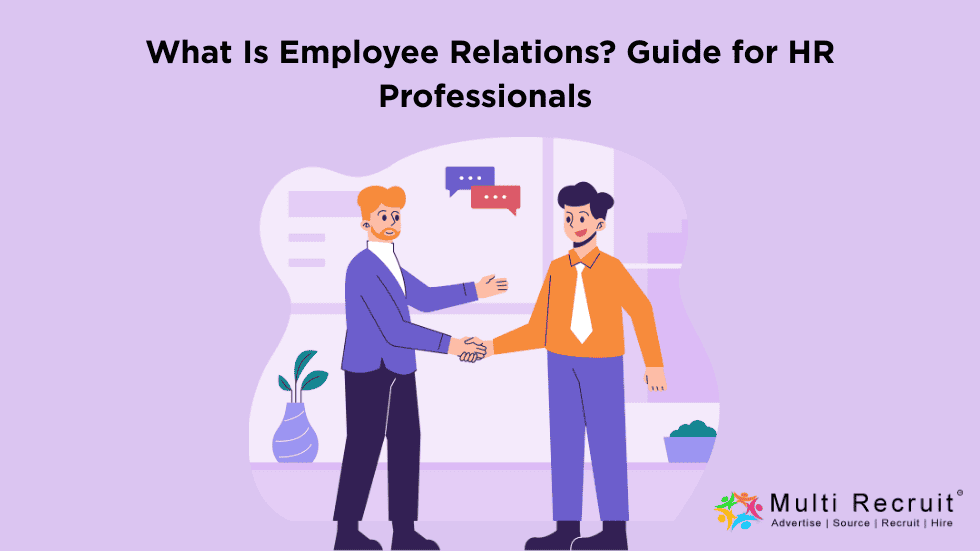Employee relations is the cornerstone of a positive workplace, focusing on building strong relationships between employees and employers. In 2025, it’s a strategic HR function that fosters engagement, resolves conflicts, and promotes a culture of trust. This guide explores the key aspects, trends, and best practices for HR professionals managing employee relations.
Understanding Employee Relations
Employee relations encompasses the strategies and practices used to manage interactions between employees, managers, and the organization. It involves addressing workplace issues, promoting open communication, and ensuring a supportive environment. The goal is to enhance employee satisfaction, productivity, and retention while minimizing conflicts.
In 2025, employee relations is evolving to address hybrid work, diversity, and mental health, making it a critical HR focus. It goes beyond resolving disputes to proactively building a culture of collaboration and inclusion.
Key Components of Employee Relations
- Communication: Transparent, two-way communication builds trust. Regular town halls, surveys, and open-door policies are essential.
- Conflict Resolution: Addressing disputes promptly and fairly prevents escalation. Mediation and clear grievance processes are key.
- Employee Engagement: Initiatives like recognition programs and team-building activities boost morale and loyalty.
- Policy Enforcement: Consistent application of workplace policies ensures fairness and compliance with labor laws.
- Workplace Culture: Fostering an inclusive, supportive culture aligns with employee expectations for flexibility and well-being.
Why Employee Relations Matters
Strong employee relations drive engagement, reduce turnover, and enhance productivity. In 2025, employees prioritize workplaces that value their well-being and offer growth opportunities. Effective employee relations also mitigate legal risks by addressing issues like harassment or discrimination proactively. For global organizations, it ensures consistency across diverse teams.
Trends in Employee Relations for 2025
- Hybrid Work Focus: Policies for remote and in-office employees promote fairness and collaboration.
- DEI Integration: Employee relations prioritize diversity, equity, and inclusion, with training to address unconscious bias.
- Mental Health Support: Programs like counseling services and wellness initiatives are central to employee relations.
- Technology Use: AI-driven tools analyze engagement data and predict potential conflicts, enabling proactive solutions.
- Employee Voice: Platforms for anonymous feedback and pulse surveys give employees a say in workplace decisions.
Best Practices for Employee Relations
- Foster Open Communication: Encourage regular check-ins and feedback channels to build trust.
- Train Managers: Equip managers with conflict resolution and communication skills to handle employee concerns effectively.
- Promote Inclusion: Implement DEI initiatives and ensure policies are equitable across all employee groups.
- Recognize Contributions: Use recognition programs to celebrate achievements and boost morale.
- Resolve Conflicts Promptly: Establish clear processes for addressing grievances and mediate disputes fairly.
- Leverage Technology: Use HR platforms to track engagement and identify areas for improvement.
Challenges in Employee Relations
Common challenges include managing conflicts in hybrid work settings, addressing diverse employee needs, and ensuring consistent policy application. Resistance to change and lack of manager training can also hinder efforts. Overcoming these requires clear communication, robust systems, and ongoing training.
The Future of Employee Relations
In 2025, employee relations will focus on flexibility, inclusion, and technology. AI will enhance engagement analytics, while hybrid work policies will evolve to meet employee needs. A focus on mental health and DEI will strengthen workplace culture, making employee relations a key driver of organizational success.
Conclusion
Employee relations in 2025 are about building trust, resolving conflicts, and fostering an inclusive culture. By prioritizing communication, engagement, and fairness, HR professionals can create a thriving workplace. Tools from providers like Multi Recruit can support these efforts with advanced analytics, ensuring employee relations remain a strategic asset.
Frequently Asked Questions
1. What is employee relations, and why is it critical in 2025?
Employee relations focuses on managing relationships between employees, managers, and the organization to foster a positive workplace. It involves communication, conflict resolution, and engagement strategies. In 2025, it’s critical due to hybrid work, diversity expectations, and mental health priorities. Strong employee relations boost engagement, reduce turnover, and create a collaborative culture, making it a key driver of organizational success.
2. What are the core components of effective employee relations?
The core components include transparent communication (e.g., open-door policies, surveys), conflict resolution (e.g., mediation, grievance processes), employee engagement (e.g., recognition programs), policy enforcement (e.g., consistent application of workplace rules), and fostering an inclusive culture. In 2025, these elements emphasize flexibility and well-being to meet diverse employee needs in hybrid work environments.
3. How does technology enhance employee relations in 2025?
Technology, such as AI-driven HR platforms, enhances employee relations by analyzing engagement data, predicting conflicts, and identifying areas for improvement. Tools like pulse surveys and anonymous feedback platforms give employees a voice, while mobile apps facilitate communication in hybrid settings. In 2025, technology enables proactive solutions, ensuring timely interventions and stronger workplace relationships.
4. What challenges do HR professionals face in managing employee relations?
Challenges include resolving conflicts in hybrid work environments, addressing diverse employee needs, and ensuring consistent policy application across global teams. Resistance to change, lack of manager training, and cultural misunderstandings can also hinder efforts. Overcoming these requires clear communication, regular training, and robust systems to support equitable and inclusive practices.
5. How can organizations strengthen employee relations in 2025?
Organizations can strengthen employee relations by fostering open communication through regular check-ins, training managers in conflict resolution, and promoting diversity, equity, and inclusion (DEI) initiatives. Recognizing employee contributions, leveraging technology for engagement insights, and prioritizing mental health support are key. Clear processes for addressing grievances and a focus on flexible, inclusive policies also enhance relations in 2025.

